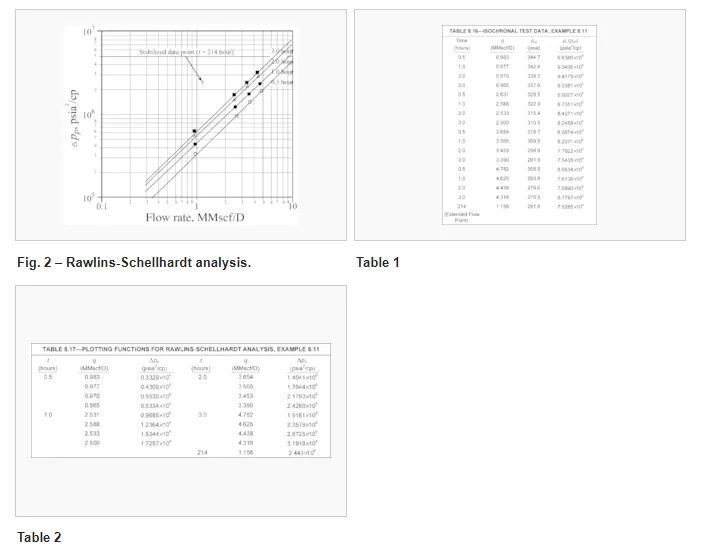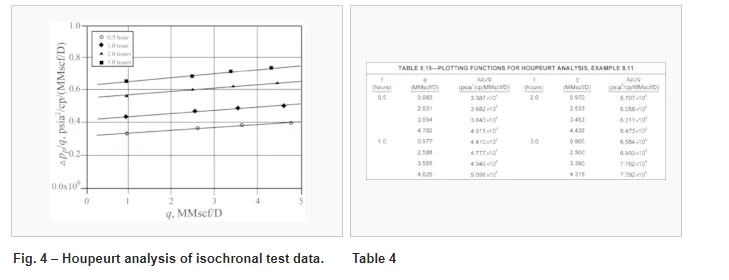
Isochronal tests for gas wells
The isochronal test is a series of single-point tests developed to estimate stabilized deliverability characteristics without actually flowing the well for the time required to achieve stabilized conditions at each different rate. This article discusses the implementation and analysis of the isochroncal testing for gas well deliverability tests. Both the Rawlins and Schellhardt and Houpeurt analysis techniques are presented in terms of pseudopressures.
Isochronal test procedure and analysis
The isochronal test is conducted by alternately producing the well then shutting it in and allowing it to build to the average reservoir pressure before the beginning of the next production period. Pressures are measured at several time increments during each flow period. The times at which the pressures are measured should be the same relative to the beginning of each flow period. Because less time is required to build to essentially initial pressure after short flow periods than to reach stabilized flow at each rate in a flow-after-flow test, the isochronal test is more practical for low-permeability formations. A final stabilized flow point often is obtained at the end of the test. Fig. 1 illustrates an isochronal test.
Fig. 1 – Pressure and flow rate history of a typical isochronal test.
The isochronal test is based on the principle that the radius of drainage established during each flow period depends only on the length of time for which the well is flowed and not the flow rate. Consequently, the pressures measured at the same time periods during each different rate correspond to the same transient radius of drainage. Under these conditions, isochronal test data can be analyzed using the same theory as a flow-after-flow test, even though stabilized flow is not attained. In theory, a stabilized deliverability curve can be obtained from transient data if a single, stabilized rate and the corresponding BHP have been measured and are available.
The transient flow regime is modeled by
where ps is the stabilized BHP measured before the test. The transient equation can be rewritten in a form similar to the stabilized equation for a circular drainage area. To start this process, write
Further, a transient radius of drainage is defined as
By substituting Eq. 3 into Eq. 2 and rearranging, the transient solution becomes
which is valid at any fixed time because rd is a function of time and not of flow rate. rd has no rigorous physical significance. It is simply the radius that forces the transient equation to resemble the pseudosteady-state equation. In addition, do not confuse rd with ri, which is the transient radius of investigation given by Eq. 5.
Similar to Houpeurt’s equations, rewrite Eq. 4 as
where
b is not a function of time and will remain constant. Similarly, the intercept at is constant for each fixed time line or isochron.
The theory of isochronal test analysis implies that the transient pressure drawdowns corresponding to the same elapsed time during each different flow period will plot as straight lines with the same slope b. The intercept a t for each line will increase with increasing time. Therefore, draw a line with the same slope, b, through the final, stabilized data point, and use the coordinates of the stabilized point and the slope to calculate a stabilized intercept, a, independent of time, where (for radial flow) the stabilized flow coefficient is defined by
Rawlins-Schellhardt analysis
In logarithmic form, the empirical equation introduced by Rawlins and Schellhardt for analysis of flow-after-flow test data is
For isochronal tests, plot transient data measured at different flow rates but taken at the same time increments relative to the beginning of each flow period. The lines drawn through data points corresponding to the same fixed flow time prove to be parallel, so the value of n is constant and independent of time. However, the intercept, log (C), is a function of time, so a different intercept must be calculated for each isochronal line. This "transient" intercept is log (Ct). In terms of this transient intercept, Eq. 11 becomes
![]() is replaced by ps in the modified equation.
is replaced by ps in the modified equation.
The conventional Rawlins-Schellhardt method of isochronal test analysis is to plot
for each time, giving a straight line of slope 1/n and an intercept of
Houpeurt analysis
Recall that the Houpeurt equation for analyzing flow-after-flow tests is
Eq. 13 assumes stabilized flow conditions; however, in isochronal testing, measured transient data are being recorded. Consequently, for each isochronal (or fixed time) line, the equation for transient flow conditions is
where
The form of Eq. 14 suggests that a plot of Δpp/q = [pp(ps) – pp(pwf,s)]/q vs. q will yield a straight line with slope b and intercept at. This theory can then be extended to the stabilized point and calculate a stabilized intercept, a, using the coordinates of the stabilized point. The slope b remains the same.
Example: Analysis of isochronal tests
Estimate the absolute open flow (AOF) of this well[1] using both the Rawlins and Schellhardt and the Houpeurt analyses. Table 1 summarizes the isochronal test data. Assume pb = 14.65 psia.
Solution
Rawlins-Schellhardt analysis technique. First, plot Δpp = pp(ps) – pp(pwf ) vs. q on log-log coordinates (Fig 2) and include the single stabilized, extended flow point. Table 2 gives the plotting functions.

Calculate the deliverability exponent, n, for each line or isochron using least-squares regression analysis. Note that, because the first data point for each isochron does not align with the data points at the last three flow rates (Fig. 2), the first data point is ignored in all subsequent calculations.
Table 3 summarizes the deliverability exponents determined with a least-squares regression analysis for each isochron. The arithmetic average of the n values in Table 3 is 0.89.
Table 3
Because 0.5 ≤ ![]() ≤ 1.0, AOF can be calculated or determined graphically using Fig. 3. AOF will be calculated in this example. First, determine the stabilized performance coefficient using the coordinates of the stabilized, extended flow point and n =
≤ 1.0, AOF can be calculated or determined graphically using Fig. 3. AOF will be calculated in this example. First, determine the stabilized performance coefficient using the coordinates of the stabilized, extended flow point and n = ![]() :
:
Then calculate the AOF potential:
To determine the AOF graphically, first calculate the pseudopressure at pb and compute
Then, draw a line of slope 1/![]() through the stabilized flow point, extrapolate the line to the flow rate at Δpp = pp(ps) − pp(pb), and read the AOF directly from the graph. The result is qAOF = 4.04 MMscf/D.
through the stabilized flow point, extrapolate the line to the flow rate at Δpp = pp(ps) − pp(pb), and read the AOF directly from the graph. The result is qAOF = 4.04 MMscf/D.
Fig. 3 – Rawlins-Schellhardt analysis result.
Houpeurt analysis technique. Plot Δpp/q = [pp(ps) – pp(pwf )]/q vs. q on Cartesian graph paper (Fig. 4). Table 4 gives the plotting functions. Construct best-fit lines through the isochronal data points for each time. Note that, for each flow time, the point corresponding to the lowest rate does fit on the same straight line, so all four data points will be used for the analysis of each isochron.

Next, determine the slope b of each line or isochron. Values of b from least-squares regression analysis are summarized in Table 5. The arithmetic average value of the slopes in Table 5 is 2.074 × 104 psia2/cp/(MMscf/D)2.
Table 5
Calculate the stabilized isochronal deliverability line intercept using Δpp/q = 2.113 × 106 psia2/cp/(MMscf/D) at the extended, stabilized point.
Calculate the AOF potential using the average value of b and the stabilized value of a.
Fig. 5 illustrates the results.
Fig. 5 – Houpeurt analysis of isochronal test data result.